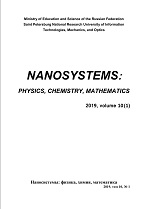|
MATHEMATICS
Spin Boltzmann machine
Igor S. Lobanov
Faculty of Physics, ITMO University, Saint Petersburg, Russia
Abstract:
Boltzmann machine (BM) is a recurrent network, which has a wide range of applications in machine learning (ML) including dimensionality reduction, feature learning and classification. Standard BM is described by the Ising model and can be implemented as a spin ice based device. Such hardware implementation is faster and more energy efficient than a simulation on digital computers. At the moment, a hardware BM is a single purpose device designed on digital computers for a specific task. In the paper we propose a generalized BM capable of fitting parameters by demonstration of training examples, which is done completely inside the spintronic device. Our generalization is based on the Heisenberg model, which is more accurate than the Ising model for spin ice. We show that for some systems minimization of Kullback-Leibler divergence during training of BM is equivalent to minimization of free energy with respect to the biases of the units, hence training of the ML model can be done by energy dissipation. We include the biases as degrees of freedom of the device, whose dynamics is described by the same
Landau–Lifschitz–Gilbert equation as for spins representing units of BM. The demonstration of samples from the training set is done by fixing inputs and outputs according to ground truth. The training samples are remembered by the machine becoming minima on the energy landscape implementing a kind of long-term potentiation. The performance of the proposed machine is compared with a single layer perceptron artificial neural network and with a Bernoulli restricted BM on a binary classification problem.
Keywords:
spectral gap, quantum graph, Schrödinger operator, discrete spectrum.
Received: 26.10.2022
Revised: 17.11.2022
Accepted: 30.11.2022
Citation:
Igor S. Lobanov, “Spin Boltzmann machine”, Nanosystems: Physics, Chemistry, Mathematics, 13:6 (2022), 593–607
Linking options:
https://www.mathnet.ru/eng/nano1142 https://www.mathnet.ru/eng/nano/v13/i6/p593
|

| Statistics & downloads: |
| Abstract page: | 53 | | Full-text PDF : | 42 |
|




 Contact us:
Contact us: Terms of Use
Terms of Use
 Registration to the website
Registration to the website Logotypes
Logotypes







 Citation in format
Citation in format 